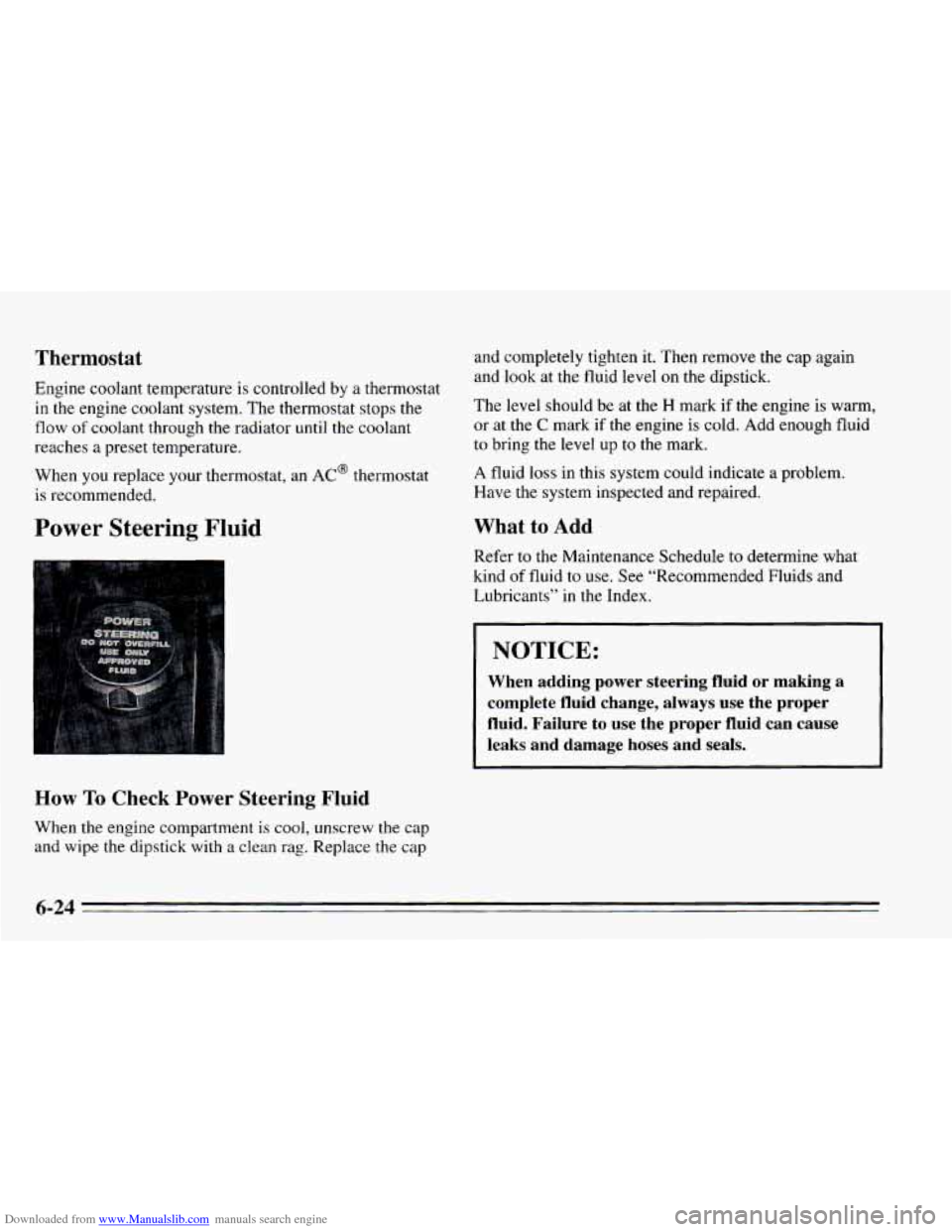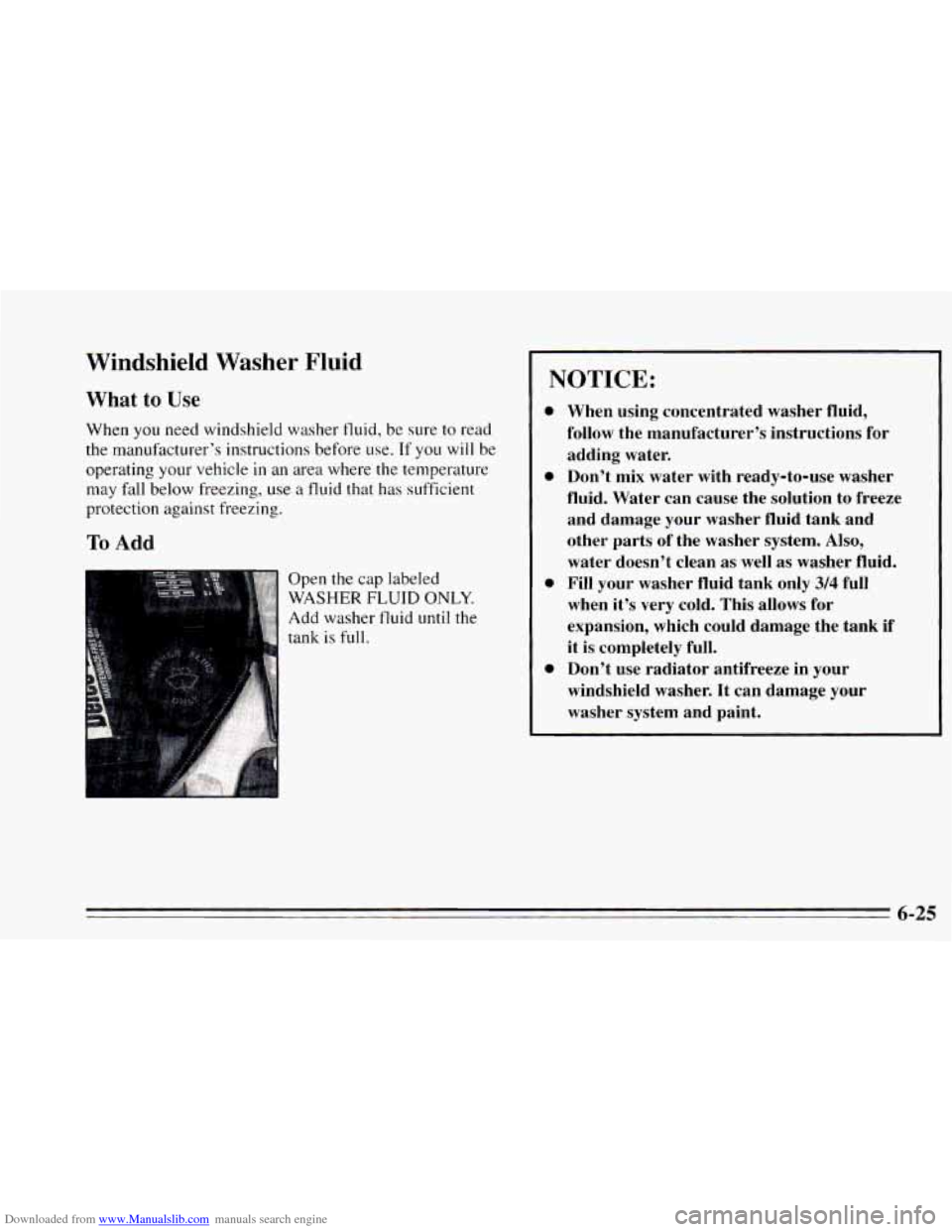Page 193 of 340
Downloaded from www.Manualslib.com manuals search engine NOTICE:
In cold weather, water can freeze and crack the
engine, radiator, heater core and other parts.
So
use the recommended coolant.
I. You can remove the coolant surge tank pressure cap
when the cooling system, including
the coolant surge
tank pressure cap and upper radiator hose,
is no
5-17
Page 195 of 340
Downloaded from www.Manualslib.com manuals search engine 4. With the coolant surge tank pressure cap off, start the
engine and let
it run until you can feel the upper
radiator hose getting hot. W'ltch
out for the engine
fan.
By this time, the coolant level inside the coolant
surge tank
may be lower. If the level is lower, add
more
of the proper mix to the coolant surge tank
until the level reaches the FULL COLD mark.
5. Then replace the
pressure cap.
Be
sure the pressure
cap is tight.
5-19
Page 228 of 340

Downloaded from www.Manualslib.com manuals search engine Thermostat
Engine coolant temperature is controlled by a thermostat
in the engine coolant system. The thermostat stops the
flow of coolant through the radiator until the coolant
reaches
a preset temperature.
When
you replace your thermostat, an AC’ thermostat
is recommended.
Power Steering Fluid
How To Check Power Steering Fluid
When the engine compartment is cool, unscrew the cap
and wipe the dipstick with a clean rag. Replace the cap and
completely tighten
it. Then remove the cap again
and look at the fluid level
on the dipstick.
The level should be at the
H mark if the engine is warm,
or at the
C mark if the engine is cold. Add enough fluid
to bring the level up
to the mark.
A fluid loss in this system could indicate a problem.
Have the system inspected and repaired.
What to Add
Refer to the Maintenance Schedule to determine what
kind
of fluid to use. See “Recommended Fluids and
Lubr’
nts” in the Index.
I NOTICE:
~~
When adding power steering fluid or making a
complete fluid change, always use the proper
fluid. Failure to use the proper fluid
can cause
leaks and damage hoses and seals.
6-24
Page 229 of 340

Downloaded from www.Manualslib.com manuals search engine Windshield Washer Fluid
What to Use
When you need windshield washer fluid, be sure to read
the manufacturer’s instructions before use. If you will be
operating your vehicle
in an area where the temperature
may fall below freezing, use
a fluid that has sufficient
protection against freezing.
To Add
Open the cap labeled
WASHER FLUID ONLY.
Add washer fluid until the
tank
is full.
I NOTICE:
0
a
0
0
When using concentrated washer fluid,
follow the manufacturer’s instructions for
adding water.
Don’t mix water with ready-to-use washer
fluid. Water can cause the solution to freeze
and damage your washer fluid tank and
other parts
of the washer system. Also,
water doesn’t clean as well as washer fluid.
Fill your washer fluid tank only
3/4 full
when it’s very cold. This allows for
expansion, which could damage the tank
if
it is completely full.
Don’t use radiator antifreeze in your
windshield washer.
It can damage your
washer system and paint.
6-25
Page 273 of 340

Downloaded from www.Manualslib.com manuals search engine Maintenance Schedule I
30,000 Miles (50 000 km)
0 Change engine oil and filter (or every
3 months, whichever occurs first).
An Emission Control Service.
0 Lubricate the suspension, steering linkage
and
the transaxle shift linkage (or every
6 months, whichever occurs first).
[7 Inspect engine accessory drive belt (or
every
24 months, whichever occurs first).
0 Drain, flush and refill cooling system (or
every 24 months, whichever occurs first).
See “Engine Coolant”
in the Index for what
to use. Inspect hoses. Clean radiator,
condenser, pressure cap and neck. Pressure
test the cooling system and pressure cap.
0 Inspect spark plug wires (except 2.3L Code
An Emission Control Service.
An Ernission Control Service.
D engine). An Emission Control Service.
0 Replace air cleaner filter. Replace filter
more often under dusty conditions.
An Emission Control Service.
0 Inspect Exhaust Gas Recirculation (EGR)
system (2.2L Code
4 engine only).
An Emission Control Servicu. -t-
0 Inspect fuel tank, cap and lines for damage
or leaks. Inspect fuel cap gasket for any
damage. Replace parts as needed.
0 Rotate tires. See “Tire Inspection and
Rotation”
in the Index for proper rotation
pattern and additional information.
An Emission Control Service.
DATE SERVICED BY ACTUAL MILEAGE
7-11
Page 279 of 340
Downloaded from www.Manualslib.com manuals search engine I Maintenance Schedule I 1
57,000 Miles (95 000 km)
0 Change engine oil and filter (or every
3 months, whichever occurs first).
An Emission Control Service.
I DATE ACTUAL MILEAGE SERVICED BY
60,000 Miles (100 000 km)
0 Change engine oil and filter (or every
3 months, whichever occurs first).
An Emission Control Service.
0 Lubricate the suspension, steering linkage
and
the transaxle shift linkage (or every
6 months, whichever occurs first).
0 Inspect engine accessory drive belt (or
every
24 months, whichever occurs first).
0 Drain, flush and refill cooling system (or
every
24 months, whichever occurs first).
See “Engine Coolant”
in the Index for what
to use. Inspect hoses. Clean radiator,
condenser, pressure cap and neck. Pressure
test the cooling system and pressure cap.
An Emissiorr Control Service.
An E~nission Control Service.
(Continued)
7-17
Page 285 of 340

Downloaded from www.Manualslib.com manuals search engine Maintenance Schedule I
90,000 Miles (150 000 km)
0 Change engine oil and filter (or every
3 months, whichever occurs first).
An Emission Control Service.
0 Lubricate the suspension, steering linkage
and the transaxle shift linkage (or every
6 months, whichever occurs first).
every
24 months, whichever occurs first).
An Enzission Control Service.
0 Drain, flush and refill cooling system (or
every
24 months, whichever occurs first).
See “Engine Coolant’’ in the Index for what
to use. Inspect hoses. Clean radiator,
condenser, pressure cap and neck. Pressure
test the cooling system and pressure cap.
An Emission Control Service.
0 Inspect engine accessory drive belt (or
0 Inspect spark plug wires (except 2.3L Code
D engine). An Emissiou Control Setvice.
0 Replace air cleaner filter. Replace filter
more often under dusty conditions.
An Emission Control Ser\?ice.
0 Inspect fuel tank, cap and lines for damage
or leaks. Inspect fuel cap gasket for any
damage. Replace parts
as needed.
An Emissiorz Control Serviw.
7-23
Page 291 of 340

Downloaded from www.Manualslib.com manuals search engine Maintenance Schedule I1
30,000 Miles (50 000 km)
0 Change engine oil and filter (or every
12 months, whichever occurs first).
An Emission Control Service.
Lubricate the suspension, steering linkage
and the transaxle shift linkage (or every
12 months, whichever occurs first).
Inspect engine accessory drive belt (or
every 24 months, whichever occurs first).
fl Drain, flush and refill cooling system (or
every
24 months, whichever occurs first).
See “Engine Coolant” in the Index for what
to use. Inspect hoses. Clean radiator,
condenser, pressure cap and neck. Pressure
test the cooling system and pressure cap.
An Emission Control Service.
0 Inspect spark plug wires (except 2.3L Code
An Emission Control Service.
D engine). An Emission Control Service.
Replace air cleaner filter. An Emission Control
0 Inspect fuel tank, cap and lines for damage
or leaks. Inspect fuel cap gasket for any
damage. Replace parts as needed.
Service.
An Emission Control Service.
0 Inspect Exhaust Gas Recirculation (EGR)
system
(2.2L Code 4 engine only).
An Emission Control Service.
I I I
7-29